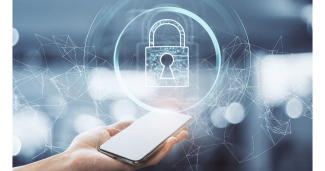
6 Useful Cybersecurity Tips for Your Financial, Social, Email, and Mobile Accounts
If you ever watched the 1995 film Apollo 13 directed by Ron Howard, you might remember the scene where they literally used duct tape and cardboard to save astronauts. As I reminisce about watching that movie, I marvel at the incredible technological progress and innovation that has been made in the last 50 years.
Do you remember the days of the road atlas and pay phones? I do. Early in my career, I remember driving around Atlanta with the large road atlas trying to find businesses or homes for meetings. If I got lost or was running late, I had to find a quarter and a pay phone to call.
Things are certainly different today. GPS, cellular networks, smart phones, and real time maps with traffic alerts and instant directions have made life so much easier as we travel from place to place.
Dan Sullivan, founder and president of The Strategic Coach Inc., called the invention of the microchip the fourth “Great Crossover” – transformational technology or communication breakthroughs not unlike the inventions of the printing press or the telephone.
These innovations have made things more convenient, faster, and easier in many areas of life. Managing our finances is one of these areas. Online banking, electronic transfers, and monitoring our balance sheet and investments in real-time are just a few examples.
Like most things in life, there are trade-offs and risks. As more and more aspects of our personal lives are conducted online, the danger of falling prey to cybercriminals and identity thieves is a particular threat that must be guarded against.
The good news is that many personal security strategies are often not as complicated as one might think. We've gathered some tips below from experts in the field of cybersecurity. While this article is in no way intended to be a complete list of strategies and the assistance of professionals is often recommended, here are a few best practices you can adopt to protect yourself:
1. Make yourself a difficult target for cybercriminals
Cybercriminals devise schemes to trick you into giving them an entry way into your digital world. They’ll try to steal the log-in credentials to your financial accounts, your email, and/or your mobile phone, with the goal of moving money from your accounts to accounts they control. Taken as a group, these identity thieves are formidable adversaries: highly skilled and sophisticated, and employing techniques and technology tools to deceive you. The most effective strategy for keeping them out is to lock down the most common entry points.
Many cyber crime experts say one of the easiest, high impact ways to get started is to use a password manager to keep track of your passwords. If you are not using a password manager, a sheet of paper, in a secure place, is better than reusing or choosing weak passwords or keeping them in and electronic document or spreadsheet on your computer.
2. Protect your financial accounts—employ extra layers of protection for accounts of value
- Use a strong and unique username and password
- Employ two-factor authentication (2FA) for all financial accounts and sites that store your financial information (debit card, credit card, bank account number, etc.). A 2FA is the addition of a second step (e.g., an extra, one-time password) to the log-in process; the feature is generally available, but must be enabled, on financial, social, and email accounts
- Leverage alerts on all financial accounts to warn you of suspicious activity
- Freeze your credit—this will make it more difficult for thieves to open new accounts in your name. Read more about how to do it at the U.S. Federal Trade Commission website
3. Protect your email account(s)
- Use a strong and unique password
- Employ 2FA
- Don’t keep sensitive data (like account numbers) in your email folders
4. Protect your mobile account
- Use a strong and unique password
- Employ 2FA for online accounts whenever possible
- Manage “trusted devices”
5. Protect your computer
- Keep operating system up to date (auto-update is recommended)
- Use anti-virus software and keep it up to date
- Be very cautious when clicking on email attachments or links
- If possible, use a dedicated device for financial transactions
- Be wary of Wi-Fi networks: All browsing that involves sensitive information should be on a network you trust
- Don’t save passwords or credit card numbers in your web browser
6. Your Digital Footprint – Understand and Protect it
Online personal information can invite unwanted attention—make sure you know what’s “out there” about you and your family. And when it comes to sharing personal details on social media, be aware of the extent of your total household exposure, and understand that what you and your other family members put out on the internet for well-intended purposes can be used against you by criminals.
Limit disclosure. Don’t share unnecessary personal details on social media.
Enable security features. Find the security settings (like two-factor authentication) on social media sites and use them to protect your accounts.
Leverage privacy settings to distinguish between accounts and posts you want to be public and ones you want to be private.
Don’t share information as it happens. Example: “We are boarding our flight to Europe!”
Get everyone on the same page. Ensure that other family members know the risks and act accordingly—remember, a chain is only as strong as its weakest link. Decide as a family what your preferred level of privacy/discretion is and be consistent among all family members.
Periodically “audit” your digital footprint. In addition to checking yourself, consider hiring a third party to assess your online exposure; these professionals know how to look deeper and wider to see what information is available.
Many cybersecurity professionals agree it is critical to act quickly if you think you've been compromised. If you think your financial account has been compromised, contact your financial advisor and financial institution immediately. It's important to log in to your account(s) from a different device and create new passwords if you think your financial and/or email accounts have been compromised.
If you would like to learn more or hear from and expert on these topics, check out The Money and Meaning Show podcast episode: Why is Cyber Crime on the Rise and How Can You Protect Yourself? with Steve Ryder of True North Networks.
At TandemGrowth, we use technology extensively to run our firm as well as to collaborate with our clients. We strive to partner with an outsourced technology specialist to educate us and employ security features and maintenance in an effort to protect sensitive information. Our employees undergo periodic training in an attempt to stay up-to-date on the latest threats and best practices. If we may answer any questions, please do not hesitate to reach out.
Additional Resources:
Setting up 2FA and “Trusted Devices” on Apple products: https://support.apple.com/en-us/HT204915
Adding 2FA to Samsung devices: https://account.samsung.com/membership/guide/2step/gate
Most email providers—Google, Microsoft, Yahoo, Verizon, AT&T, etc.—also offer two-factor authentication as a security option. A web search of your provider plus “two-factor authentication” or “two-step verification” will lead you to instructions.


